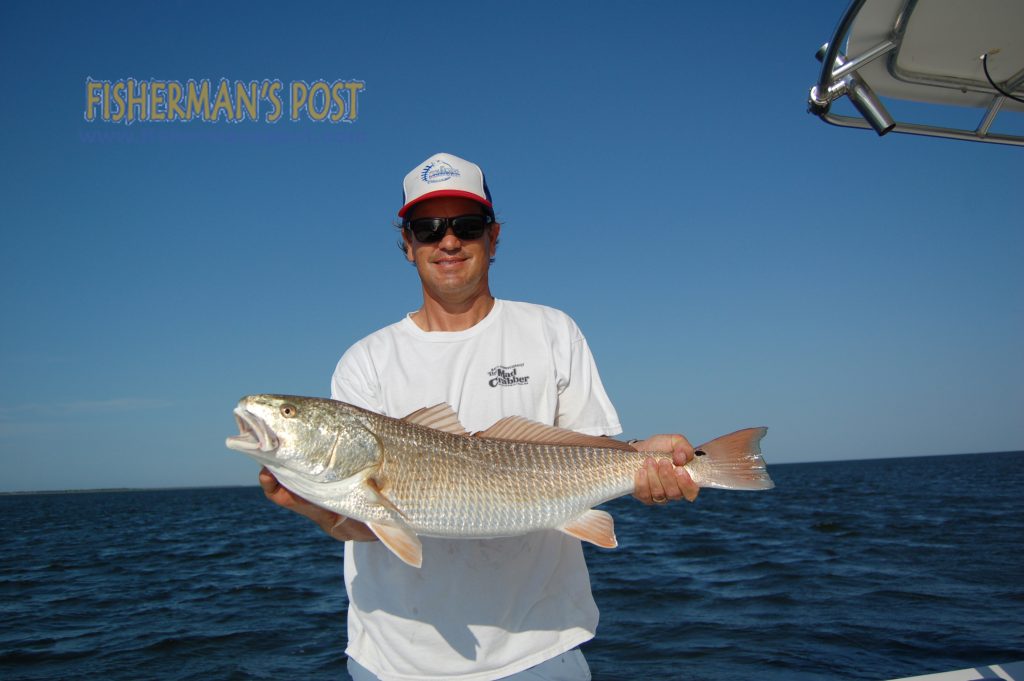Tidelines – July 30, 2015
At Hatteras Harbor Marina that morning, Capt. Aaron Aaron, of Tightline Charters, had told me that on the grass flats themselves we would most likely see singles and doubles and maybe a small knot or two of fish. The bigger schools, he continued, would probably be on the edges of the grass flats and in the drop-offs (down to about 3’ of water) that bordered the miles of flats we would be targeting.

A close-up of the Johnson gold spoon rig that Capt. Aaron Aaron uses for a variery of fish in the Hatteras area–a split ring connected directly to the spoon, and then a barrel swivel connected directly to the ring.
Our plan was to try and sight cast to these reds on the flats behind Hatteras and Frisco. I noted the west/southwest wind that was already blowing a little at 7:00 am, concerned it would hamper our sight casting efforts, but Aaron told me he liked that wind for three reasons.
The first reason, he explained, was because the wind would help us cover more ground. He would position his 24’ Kencraft towerboat so that the wind would push us to cover as much of the flat as possible.

Kelly Hogan, from Nags Head, with an over-slot red drum caught using a gold spoon on a grass flat behind Frisco. He was fishing with Capt. Aaron Aaron of Tightline Charters out of Hatteras Harbor Marina.
The second reason was his belief that when the water is too calm the reds are too easy to spook—they hear everything and better feel the vibrations of the boat and motor.
The last reason was the direction of the wind that morning. When it blows west or southwest, the tide drains out of the sound and makes the water more shallow, and more shallow makes it easier to find the fish.
After a relatively short run, Aaron had the boat in position to make our first drift. He gave a rod rigged with a Johnson gold spoon to both me and Kelly Hogan (an old college buddy of mine I had invited along that coincidentally also happened to be an old junior high school buddy of Aaron’s, the two of them growing up surfing together in Virginia Beach).
Aaron loves fishing gold spoons. As a guide, he takes people of all different skill levels fishing, and the gold spoons work effectively for everyone but especially for those with little fishing experience.
The spoons are easy to cast, and the instructions he gives his clients are simple—give them a straight crank with a steady retrieve. You don’t have to bump them or twitch them, and they don’t get grassed up because you’re pulling them back just over the grass.
And to make the gold spoon tactic even more effective (again, especially for those with little experience), he rigs his gold spoons by connecting a split ring to the spoon and then a barrel swivel to the split ring, as opposed to the more traditional way to rig them by tying about 1-2’ of fluoro to the spoon and then inserting a barrel swivel to connect the fluoro to braid.
His reasoning? The barrel swivel on the spoon doesn’t keep the fish from striking—he gets the same amount of bites—but not having the barrel swivel 1-2’ up the line does keep his clients from reeling the barrel swivel up past the rod tip and breaking off guides.
Kelly was the first to find a red cruising the flats, bringing in an over-slot red drum after a very visual fight. We were in about 2’ of water with no deep water escape, so we saw the red the entire time from hookup to release. The red gave us a show including tail wakes, tail slaps, head and back breaking the water’s surface, and laps around the boat.
Aaron stayed up in his tower while Kelly and I worked the flat, finding a handful more singles (just like Aaron had predicted we would find on top of the flats) of varying sizes (some slot, some over, some under) but no doubles or small knots of fish. So we picked up and moved on to another flat, and just on the outside of this second flat (again, just as predicted) we “parted the red sea,” spooking a school of an estimated 100+ fish.
We kept an eye on our school, let them settle back down, and then started bombing them with the spoons from afar. Soon Kelly and I were once again hooking up with mostly over-slot red drum. If catching red drum on miles of flats in less than 3’ of water sounds like a good time, then check out Capt. Aaron Aaron of Tightline Charters in Hatteras Harbor Marina. He targets everything from flounder to trout to cobia to spanish to blues, but considers red drum his specialty.
If you do go with Aaron, expect to throw a gold spoon. And expect the reds to put on a show, both before and after being hooked.
